I. GRAFFITI WRITING: ROOTS AND STYLES
Marta R. Bisceglia
In any self-respecting critical essay, providing reliable sources is crucial. But how to do so when literature on the subject is almost non-existent? The only plausible source for us was dialogue, made possible by interviewing the artists and transcribing their direct point of view1Interviews with artists were conducted from 2013 to 2021. Being one of the main sources of this monographic volume, we choose to include numerous excerpts within the text. Specifically, artists from the Beijing scene were interviewed by A. Iezzi and M. Merenda, those from Shanghai by M. R. Bisceglia, while those from Chengdu by M. Merenda.. This dialogue has shaped a horizontal treatise on a topical subject that has only recently received the attention it deserves, and is still unfortunately not fully understood. While studying this varied and enigmatic subject, we have considered many questions to which we hope to give the right answers. Therefore, before crossing any geographical barrier and exploring the universe of graffiti in China, it is essential to provide an adequate terminological and etymological explanation of this topic, with the intention of trying to understand what graffiti is, who the artists are and, above all, what they mean to convey.
Firstly, care must be taken not to confuse Street Art2Street art (jietou yishu 街头艺术) – A mass media term that tries to define all the art forms performed in public places, often illegally and using the most diverse techniques. Born from graffiti writing, it has developed and evolved into different practices over time: sticker art, stencil art, poster art, video projections, sculptures, installations and performances. – a mishmash of artistic expressions (sticker art3Sticker art (tiezhi 贴纸) – A form of tagging through computer-printed stickers that may contain only the writer’s signature and/or logo or be more elaborate, including small fonts and decorations. Sticker art is quick to execute, cheap, and easy to disseminate, and is considered a sub-category of graffiti art, although some writers believe that this type of art is only for those who are afraid of using markers or spray cans., stencil art4Stencil art (mubanhua 模 版 画) – A widely used street art practice that allows shapes, symbols and letters to be reproduced in series by means of a stencil, cut in such a way as to form a physical negative of the image to be created. In short, it is a technique characterised by the use of a pattern cut out on cardboard (the stencil) that can be quickly reproduced on the wall with a spray can., poster art5Poster art (haibao 海 报) – A form of street art created by joining sheets of printed paper together to compose a large advertising-style image that can even fill entire building facades. and video art) performed in the streets often illegally – with graffiti writing6Graffiti writing (tuya shuxie 涂鸦书写) – A worldwide social, cultural and artistic phenomenon born in the 1970s in New York ghettos as a spontaneous expression, with no declared intent, of a heterogeneous group of young people belonging to the hip-hop subculture. The etymology of the word graffito derives from the Latin gràphium, or “style of engraving”, which in turn stems from the Greek gràphein (γράφειν, to scratch, to hollow, to draw). The English term “writing”, instead, stands for the act of creating one’s tag in public spaces using spray paint or markers. It entails a study of lettering, namely the style of the characters that make up both simple tags and pieces. In China, the term “graffiti” does not only refer to the writing of letters or characters as in writing, and thus graffiti is also called tuya yishu 涂 鸦 艺 术 (lit. graffiti art), implying a wide range of artistic expressions on public soil (making it much closer to street art). Another term used is tuya huihua 涂 鸦 绘 画 (lit. graffiti painting), which refers to graffiti containing puppets.: graffiti is a different kind of art (also performed in the streets). Some find it hard to place it in this “street art mishmash”, but the truth is it lays at its foundation. Although, nowadays, any pictorial work in a public place is referred to as graffiti, it is important to clarify that the artistic phenomenon we are going to analyse is “graffiti writing”.
The etymology of the word graffito derives from the Latin term gràphium (or “engraving style”), which stems from the Greek word gràphein (γράφειν, to scratch, to hollow, to draw), while the English term “writing” refers to the artistic practice that deals with the execution of letters and thus implies the study of lettering, or “the style of letters”7Lettering – The style of the letters, and the pivotal concept of graffiti writing. Writers first and foremost paint letters, which may differ in size and style: block consists of large, square or rectangular letters, usually filled with one colour; soft consists of round, soft, cloud-like shaped letters, usually of one colour within an outline; in bubble style, the letters look like soap bubbles, very precisely coloured and with a wide outline; in wildstyle, the letters are composed of intersecting three-dimensional arrows, which give the idea of movement and confusion. In the case of Chinese graffiti art, since many writers also use characters in their pieces, a new term was coined to indicate the style of the characters: Charactering..
“It’s a simple game with simple rules: get yourself a tag and write it in an original style, as often as you can, everywhere and anywhere.” (Mininno 2021, p. 29). With this premise, Alessandro Mininno, the guiding spirit of these first pages and an outstanding expert on the subject, unveils his scrupulous analysis of graffiti writing which, in general terms, can be defined as a social, cultural and artistic movement spread across the globe. This phenomenon is a spontaneous expression of a heterogeneous group of people belonging to a subculture which operates with no declared intent: the Hip-hop culture.
Hip-hop8Hip-hop (xiha 嘻哈) – A cultural movement that emerged predominantly in the Afro-American and Latino communities of the Bronx in New York, in the late 1970s. The four main aspects or elements of hip-hop culture are speech, music, movement and sign: MCing (shuochang 说 唱), or rap music introduced by Afro- Americans (MC is the acronym of Master of Ceremony); Djing (dadie 打 碟), introduced by Jamaicans; graffiti writing (tuya shuxie 涂鸦书写) and breakdance (diban wu 地板舞 o pili wu 霹雳舞), introduced by Puerto Ricans. is a cultural movement that arose among the Afro-American and Latino communities of the New York suburbs in the late 1970s. The four main aspects of hip-hop culture are: speech (rap or MCing), music (DJing), movement (breakdancing or B-boying9B-boy – Short for break-boy, or break-dancer. Over time, the term has been used to designate those who join the hip-hop culture. The female counterpart is b-girl.) and sign (writing). As a complex and structured form of visual expression in constant evolution, graffiti writing represents an act of interpreting and developing letters – so as to give birth to a proper tag10Tag (qianming tuya 签 名 涂 鸦) – The pseudonym, stage name, or code name that every graffiti artist, mc and breaker uses to distinguish themselves, to stand out and highlight their presence in the city. Being the most basic form of graffiti, created with spray cans or markers, the tag is the backbone of the writing phenomenon. The evolution of the tag represents the personal style of its author. All pieces, even the largest, most colourful and elaborate ones, remain, in essence, signatures. The activity of marking a surface with a tag is called tagging-up, while tag bombing is the reproduction of one’s tag on a large scale in a certain area of the city. Tags can also be representative of entire groups. Different writers or mcs who join together can decide to use one comprehensive tag, as a symbol of the group (see Crew)., or signature – using spray paint or markers11Marker (makebi 马克笔) – The pen used to paint tags. in public spaces.
“Signatures, or tags, thus are the backbone of the writing phenomenon. All pieces [the term by which we will henceforth refer to graffiti], even the largest, the most colourful and the most elaborate, are basically no more than tags: any illustrations and figurative characters – often found also on trains in the 1970s and 1980s – are almost always secondary, there only to enhance a composition which always revolves around lettering. It’s on the letters that a writer’s style is based,” continues Mininno.
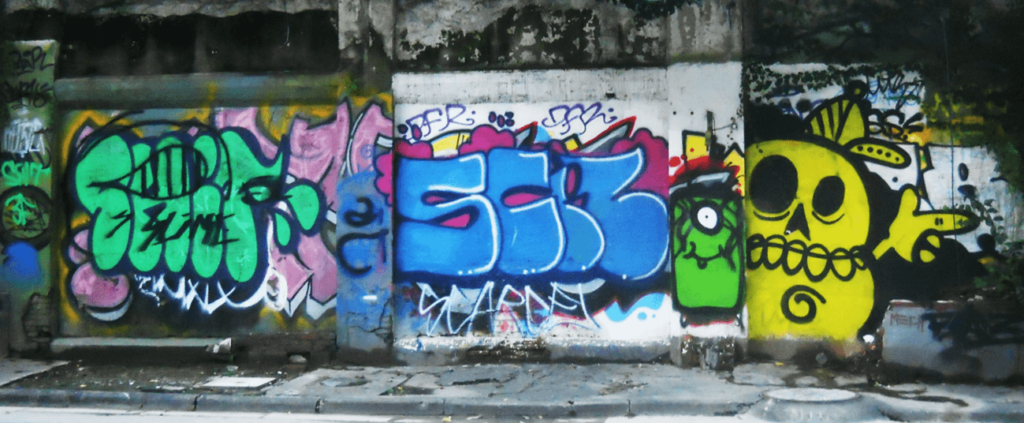
Writing is the writers12As stated by graffiti writer Rae (See Mininno 2008, p. 166).
A melting pot of low-class Afro-Americans and middle-class white kids who end up expressing themselves with clearly common means (spray paint as their medium, lettering as their subject matter and the public space as their canvas) yet often with very individual and diverse intentions. (…) Some paint for the sake of vandalism and for a ten-minute thrill in a subway tunnel, while others, closer to the artistic sentiment, prefer to spend days pouring over their letters within a legal arena (ivi, pp. 31-33), called “hall of fame”13Hall of fame (tuya qiang 涂 鸦 墙) – A space where graffiti writing is (more or less) legal. Halls of fame are mainly popular with writers who aim to create artistic, sophisticated pieces, favouring quality over quantity and constantly searching for original styles..
However, it is not just a matter of illegality: some artists’ primary objective is quantity, that is, to cover (or bomb14Bombing (zhajie 炸 街 / beng 崩) – Filling walls and trains with illegal graffiti, typically throw-ups, tags, stencils or simple lettering pieces that can be executed quickly. This is the favourite practice of writers whose primary aim is quality, and who cover the city with their tag to attain the fame of king.) entire cities’ walls with their signatures and attain the fame of “king”15King (wangzhe 王 者) – A sort of leader for other writers. Generally, the king is the best skilled writer most respected by everyone. A writer is deemed king only if another king recognises him or her as such. Factors taken into account for this title are the number of pieces made in a city, style, originality, and experience. (the best and most skilful writer, respected by all); conversely, others prefer to put the emphasis on quality, always seeking an original style. And, often, this dual nature coexists in the same person. Writers do not work alone, they normally gather in crews16Crew (tuandui 团队) – In hip hop culture, a circle of people collaborating on artistic or cultural projects, e.g., a group of writers or dancers. In graffiti writing, a crew is an organised group of writers who paint together to create pieces. They are usually friends, meaning they share mutual esteem and respect. A writer may belong to more than one crew over time, or even at the same time. The name of a crew is normally an acronym of two or three letters, possibly having multiple meanings. Like tags, crews’ names are often written on the side of the piece, or they form the very core of the piece, with the name of the crew members dotted all around., small groups of friends carrying on a common name: an acronym (usually two or three letters) serving as a brand for the whole group (Mininno 2008, p. 168). Before getting to the heart of the Chinese phenomenon, it is essential to tell the story of writing from its birth in the United States until its spread to Europe, outlining the stylistic foundations of the Old School17Old school (laoxuexiao 老 学 校) – “Slang” term referring to the subcultures of a discipline or school and its past generations. It is used to compare the current state of a discipline, subculture or movement with a previous stage. In graffiti, it refers to the early years of graffiti writing in the United States (more specifically, the mid 70s to 1983), when numerous styles were invented, making the first writers famous. The expression “back in the day” also relates to this period. Also may refer to hip-hop music of this period. Old-school writers are given respect for being there when it all started, and specific writers are remembered for creating specific styles. For example, Blade and Comet created blockbusters, Phase 2 created bubble letters, clouds, Skeme’s “S”, and so on..
American graffiti and the evolution of tags
The birth of graffiti writing dates back to the late 1960s in Philadelphia, USA, and can be traced to the activities of Cornbread and his friends. However, the Big Apple undoubtedly gave this phenomenon a decisive boost in the early 1970s, when artists like Taki 183, Julio 204 and Cat 161 painted their names on walls and in Manhattan’s underground stations (Mininno 2008, pp. 16-17). In the years following 1972, considered the crucial moment of birth and development of American graffiti, writers felt the need to transform their simple tags into forms of style experimentation. Firstly, the letters began to grow in size, and then to change, being refined and swelling into new, different styles, depending on the artist who created them. They were enriched with backgrounds, bubbles, 3D effects and arrows, as well as fill-ins and outlines.
The second stage in the evolution of the tag is the “throw-up”18Throw-up (kuaisu tuya 快速涂鸦 / outu 呕吐) – The first evolution of the tag; a stylised drawing of one’s signature, quickly executed but on a large scale, with few colours that are usually sprayed roughly, even without fill-in. The throw-up is an art of its own: the style is immediate, often very simple and “rubbery”, yet never banal. It only consists of an outline with a monochrome fill-in, but the term can sometimes also indicate any kind of bubble style, thus not necessarily monochrome. This technique is scorned because it is deemed unesthetic, but achieving a good throw-up, quickly and with a precise outline, is no easy task. The throw-up is also known as a flop. Throw-ups can be from one or two letters to a whole word or a whole roll call of names. Often times throw-ups incorporate an exclamation mark after the word or letter. or “flop”, a stylised drawing of one’s signature or its abbreviation (e.g., the first two letters), executed quickly but on a larger scale, using a few colours often roughly sprayed, even without fill-ins. Throw-up is an art in itself: the style is immediate, often very simple and rubbery but not banal, and very few colours are used (one or two) (Mininno 2021, p. 93). It is perfect for bombing.
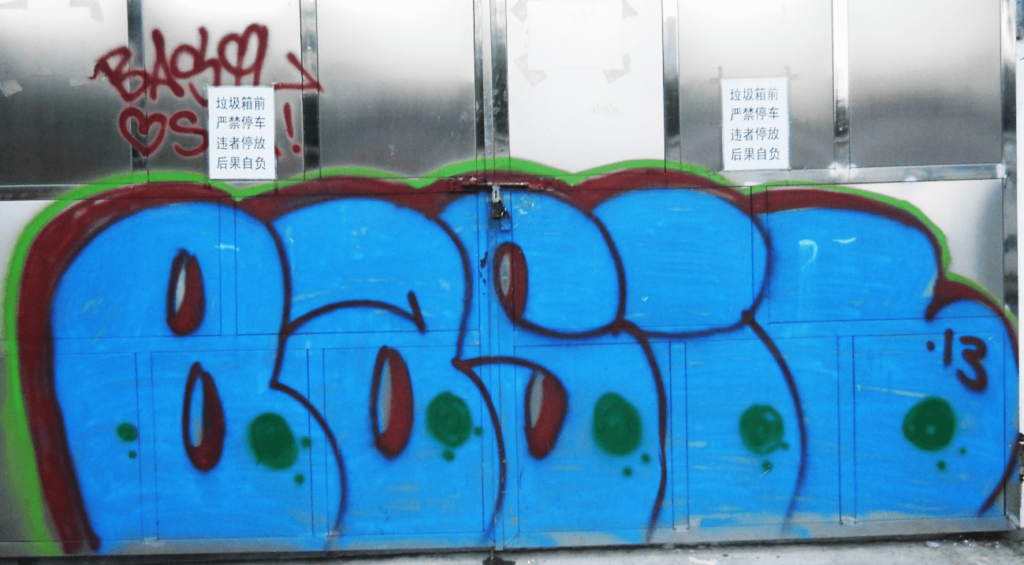
The third stage is the “piece”19Piece (zuopin 作品) – A graffiti painting, short for Masterpiece. It is also considered an enlarged tag executed with spray cans, composed of multi- coloured letters (it’s generally agreed that a painting must have at least three colors to be considered a piece). The term is generally used to distinguish graffiti from simple tags. The piece is the third stage in the evolution of letters, after the tag and the throw-up. that, if particularly successful, will stand out among the others and earn the title of “masterpiece”20Masterpiece (dafu de zuopin 大幅的作品) – A piece of excellent quality, a particularly successful graffiti..
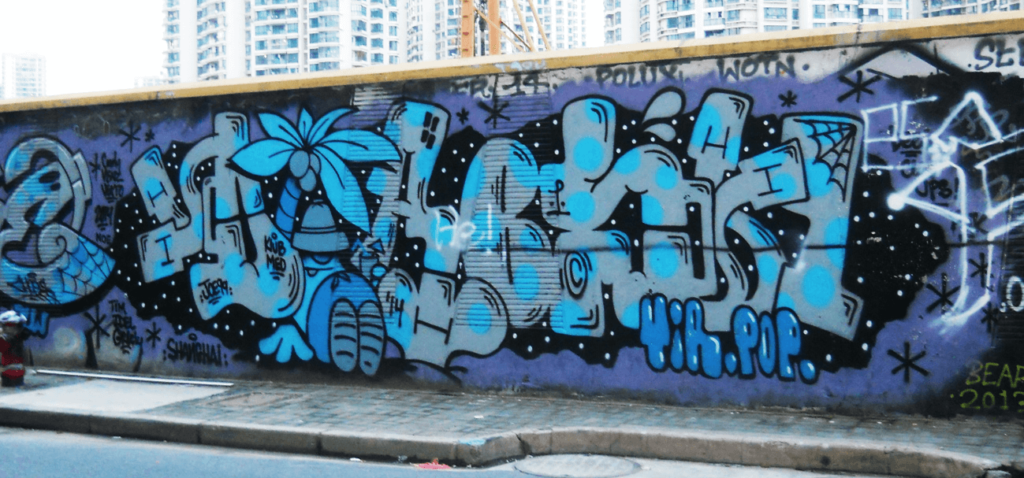
After 1972, the first pieces began to appear on entire train cars. The high visibility of the tags, the vast potential audience, and their role in creating a connection and communication between city neighbourhoods and writers, led to the much- loved practice of train bombing, that is, bombing as many trains as possible in a race to see who can create the most captivating piece. In the second half of the 1970s, more elaborate and complex styles began to emerge. 1975 saw the appearance of the term “wildstyle”21Wildstyle (kuangye fengge 狂野风格) – A complex composition of letters assembled to give a unique shape and dynamic to the piece. In this style, the letters are distorted and superimposed, and sometimes enriched with three- dimensional arrows, tribals, pikes, puppets and other decorative elements that give an idea of movement and confusion. This style can be straight or soft: the first is symmetrical, and the arrows forming the letters draw sharp angles; the second is asymmetrical, and the angles are replaced by curved arrows with rounded points. To increase the perception of depth, in addition to inserting junctions between characters, the entire word structure can be turned into a three-dimensional element. This complicated construction of interlocking letters is considered one of the hardest styles to master and the lettering of the pieces done in wildstyle is often completely undecipherable to non-writers.: softie letters started to stretch, to twist, to become separate from one another and be adorned with arrows, regardless of the overall legibility of the piece (ivi, p. 49). Wildstyle is often considered the most difficult form of writing to execute and the least readable for “non-writers”. It took less than a year for writers to realise that they could infuse the movement with a significant aesthetic evolution simply by eliminating smudges and adopting more uniform colouring and precise outlines.
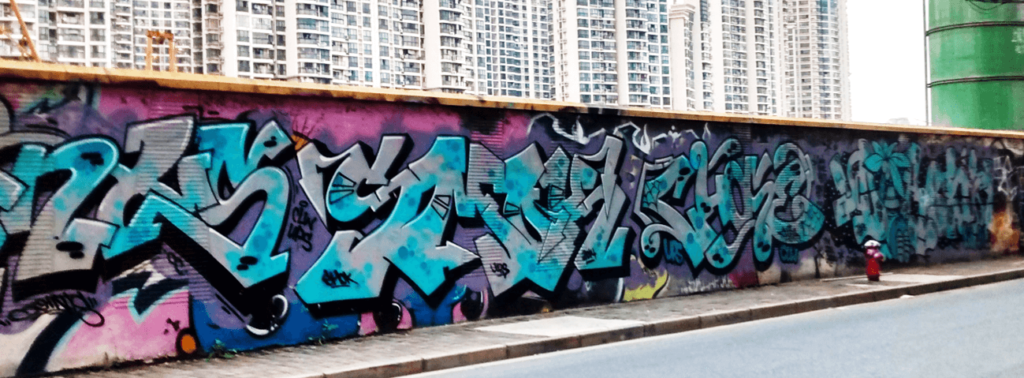
In the same period, after 1974, writers started to add figurative elements to their pieces, such as cartoon characters, known as puppets22Puppet (tu’an 图 案) – Figurative elements alongside the graffiti. These may be human figures, animal-like monsters, or comic or cartoon characters (see Character). (Mininno 2008, pp. 20-21).
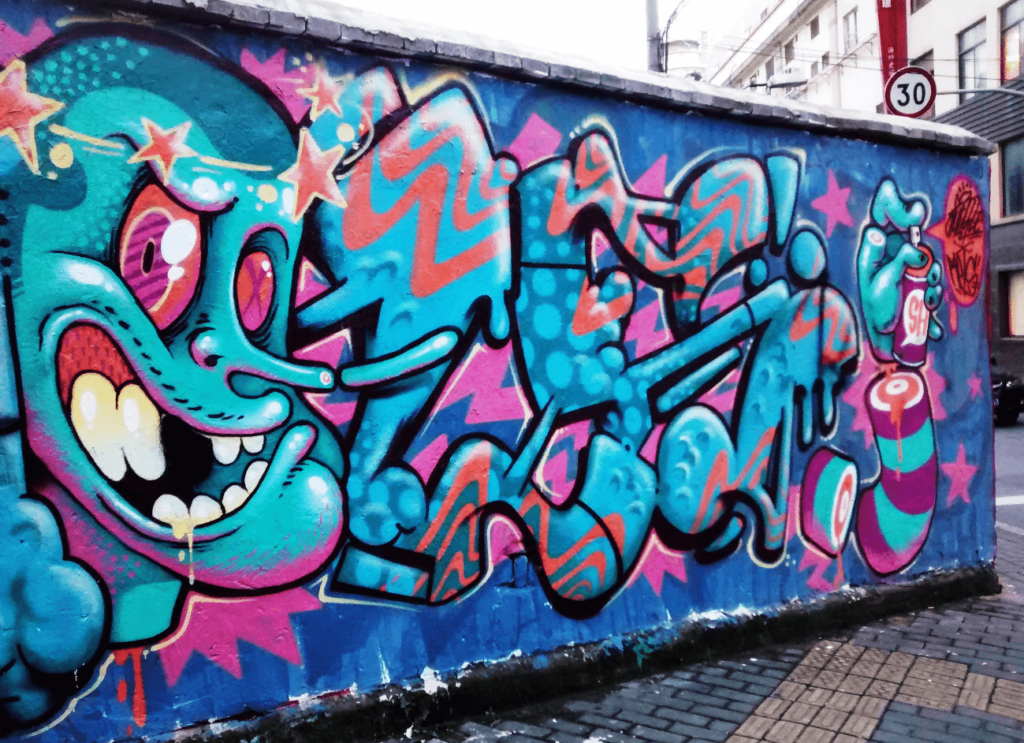
Arrival in Europe
With Keith Haring and Jean-Michel Basquiat, graffiti art officially entered the international art scene. Around 1983, with the hip-hop culture cult film Wild Style and the documentary about New York underground graffiti Style Wars, the graffiti phenomenon also found fertile ground in Europe, especially in Amsterdam and in the Parisian suburbs. Major capitals, such as London, Berlin and Paris, had already witnessed their first tags and pieces in the early 1980s. By 1987 (when the volume Spraycan Art documented writing also outside the United States), the movement had reached almost all major European cities, and writers had started to paint trains in Vienna, Düsseldorf, Munich, Copenhagen, Paris and London, although most Europeans preferred to work on walls.
Writing, which had taken more than ten years to fully develop in the Big Apple, arrived with disarming speed in Europe, its forms and methods already established. While Americans were stuck with the intricate forms of Wild Style, with all its arrows and bars, tangles and swirls that often made the final result illegible or deliberately obscure, Europe reacted (with substantial differences from nation to nation) through the evolution of more linear and often more comprehensible letters. (Mininno 2021, p. 63)
As in other European countries, writing arrived in Italy in the early 1980s, also thanks to the appearance of pieces by foreign graffiti writers, especially in Bologna and Rome. Inspiration for young writers in Italy came from cult films, foreign writers on tour, and fanzines (unofficial independent amateur magazines dealing with cultural and subcultural phenomena). From the mid-1980s to the mid-1990s, mainly thanks to hip-hop, writing spread like wildfire and went through a sequence of radical changes in styles: from the unreadable and knotted New York style to a more open and comprehensible one, which makes it possible to focus mainly on the quantity of pieces (Mininno 2008, pp. 30-39).
New frontiers: the birth of post-graffiti
After an initial phase in which the dominant element was represented by letters, contemporary graffiti culture moved towards wider horizons: the post-graffiti movement. The personal style of each artist was free to evolve without constraints and to employ a wider range of expressive means: from stickers, posters and stencils to airbrushes, oil chalks, paints and even sculpture (Ganz 2005). Post-graffiti23Post-graffiti – A modern evolution of the graffiti culture. This first break away from tradition evolved into the graffiti-logo style trend, with artists associating their name to a logo reproduced in series in public spaces through stickers, stencils and posters. Subsequently, more innovative techniques and art forms were introduced, including painting, sculpture, graphics, design, illustration, fashion, photography, architecture, video art and calligraphy. Post-graffiti is the brainchild of a global world, living and spreading over the World Wide Web. is based on stylistic trends that have their roots in the culture of graffiti writing and street art, flourishing in multiple disciplines such as painting, sculpture, graphics, design, illustration, fashion, photography, architecture, video art and calligraphy. The frontiers of this creative universe are in fact far more porous today than they used to be, and this process facilitates the rise of new styles and ways of perceiving graffiti. While graffiti writing was born and developed in the US to impose its model on a planetary scale, the post-graffiti movement has risen and spread in a global world, insofar as it lives through the Internet. The Internet is the place where people look for new models to be inspired by and publish pictures of their work.
The late advent of the graffiti movement in China – already contaminated by new experiments related to post-graffiti – led to the blossoming of a hybrid form of graffiti art. This kind of art not only echoes the fundamentals of American graffiti, but also blends with street art in a broader sense.


